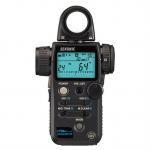
androidlad
-
Posts
1,215 -
Joined
-
Last visited
Reputation Activity
-
 androidlad got a reaction from Juank in Technical Myths and Wasted Performance of A7S III Sensor IMX510
androidlad got a reaction from Juank in Technical Myths and Wasted Performance of A7S III Sensor IMX510
1. The pixel-level read node design is similar to IMX610, only the implementation is different and dictates that it has fast conventional read speeds.
2. The physical pixels are 49 megapixels and the entire sensor is natively designed to be 49 megapixels, reusing the 4.2um BSI pixel design and using both analogue binning and digital binning together to achieve a 12 megapixel sensor.
3. IMX510 disables the all-pixel readout mode, so there is no possibility of an all-pixel readout, and naturally it cannot achieve 2x2 OCL AF, which is the biggest difference between it and IMX472.
4. Dividing IMX510's logical pixel into four physical pixels. The readout is achieved using 1:2 analogue binning before PGA and digital binning after ADC. The specifics are:
A. 48 physical megapixels, divided into upper left, upper right, lower left and lower right in-group pixels.
B. 24 mega pixels are read, binned in the form of upper left + lower right, upper right + lower left, dual stream 14bit readout.
C. 2:1 pixel binning in the digital domain to generate 12 megapixels at 15bit, discard 1bit to 14bit output.
D. The readout speed is around 21ms, approximating 48fps; when the precision is reduced to 12bit, 96fps can be achieved.
E. The ADC does not have an 11bit mode, so it cannot achieve the faster 24M 11bit -> 12M 12bit.
F. The digital binning discards 1bit of precision regardless of the mode of output, a waste of performance deliberately designed into IMX510.
G. In one video mode, the internal readout of two 3.84K/128fps 12Bit ADC streams are digitally binned, but the resolution is not twice that of 3.84K. The precision and resolution are wasted.
5. Due to the uniqueness of the readout mode, IMX510 cannot achieve any 2x1 OCL in-group AF, and the orthogonal readout pixel groups cannot be used for phase detection. Therefore the only phase focusing design for the IMX510 is masked PDAF. A focusing method using 2x2 OCL AF will only be available when the all-pixel readout mode is unlocked.
6. The hardware performance of the sensor goes well beyond the limitations of the "IMX510" name.
7. If this sensor were to be a normal Bayer sensor, the readout speed would depend only on the total number of analogue pixels before the ADC, due to the pixel readout design. Thus 48 megapixels at 24fps 14bit. For this a Modified Bayer CFA can be used, which is suitable for pixel designs with 2:1 analogue signal binning - maximising its performance and enabling dual mode switching between high resolution and oversampled high speed shooting:
Crop to 16:9 to achieve 8.5K/57.7fps 12bit, 2x4.35K/115.5fps 12bit respectively; crop slightly to 7.68K/64fps 12bit, 2x3.84K/128fps 12bit.
Notably, its 2x3.84K/128fps 12Bit readout truly has double the resolution and achieves IMX301-like oversampling performance (Sony F65RS).
8. The readout speed of any column-parallel ADC design of an image sensor must be scaled by the line readout speed, by the total number of pixels multiplied by the number of columns, and at the same level of precision comparing:
A 48 megapixel 14bit 24fps sensor reads at a larger scale than a 12 megapixel 14bit 48fps sensor, but we cannot call it a greater total number of pixels read out, but rather a faster readout, measured by miliseconds.
At a given precision, readout time (the time taken to read a frame), readout scale (how many pixels are read in a second), and readout speed (how many rows of pixels can be read in a second by a column of ADCs), are three dintinctly different and important metrics.
-
 androidlad got a reaction from sanveer in Technical Myths and Wasted Performance of A7S III Sensor IMX510
androidlad got a reaction from sanveer in Technical Myths and Wasted Performance of A7S III Sensor IMX510
1. The pixel-level read node design is similar to IMX610, only the implementation is different and dictates that it has fast conventional read speeds.
2. The physical pixels are 49 megapixels and the entire sensor is natively designed to be 49 megapixels, reusing the 4.2um BSI pixel design and using both analogue binning and digital binning together to achieve a 12 megapixel sensor.
3. IMX510 disables the all-pixel readout mode, so there is no possibility of an all-pixel readout, and naturally it cannot achieve 2x2 OCL AF, which is the biggest difference between it and IMX472.
4. Dividing IMX510's logical pixel into four physical pixels. The readout is achieved using 1:2 analogue binning before PGA and digital binning after ADC. The specifics are:
A. 48 physical megapixels, divided into upper left, upper right, lower left and lower right in-group pixels.
B. 24 mega pixels are read, binned in the form of upper left + lower right, upper right + lower left, dual stream 14bit readout.
C. 2:1 pixel binning in the digital domain to generate 12 megapixels at 15bit, discard 1bit to 14bit output.
D. The readout speed is around 21ms, approximating 48fps; when the precision is reduced to 12bit, 96fps can be achieved.
E. The ADC does not have an 11bit mode, so it cannot achieve the faster 24M 11bit -> 12M 12bit.
F. The digital binning discards 1bit of precision regardless of the mode of output, a waste of performance deliberately designed into IMX510.
G. In one video mode, the internal readout of two 3.84K/128fps 12Bit ADC streams are digitally binned, but the resolution is not twice that of 3.84K. The precision and resolution are wasted.
5. Due to the uniqueness of the readout mode, IMX510 cannot achieve any 2x1 OCL in-group AF, and the orthogonal readout pixel groups cannot be used for phase detection. Therefore the only phase focusing design for the IMX510 is masked PDAF. A focusing method using 2x2 OCL AF will only be available when the all-pixel readout mode is unlocked.
6. The hardware performance of the sensor goes well beyond the limitations of the "IMX510" name.
7. If this sensor were to be a normal Bayer sensor, the readout speed would depend only on the total number of analogue pixels before the ADC, due to the pixel readout design. Thus 48 megapixels at 24fps 14bit. For this a Modified Bayer CFA can be used, which is suitable for pixel designs with 2:1 analogue signal binning - maximising its performance and enabling dual mode switching between high resolution and oversampled high speed shooting:
Crop to 16:9 to achieve 8.5K/57.7fps 12bit, 2x4.35K/115.5fps 12bit respectively; crop slightly to 7.68K/64fps 12bit, 2x3.84K/128fps 12bit.
Notably, its 2x3.84K/128fps 12Bit readout truly has double the resolution and achieves IMX301-like oversampling performance (Sony F65RS).
8. The readout speed of any column-parallel ADC design of an image sensor must be scaled by the line readout speed, by the total number of pixels multiplied by the number of columns, and at the same level of precision comparing:
A 48 megapixel 14bit 24fps sensor reads at a larger scale than a 12 megapixel 14bit 48fps sensor, but we cannot call it a greater total number of pixels read out, but rather a faster readout, measured by miliseconds.
At a given precision, readout time (the time taken to read a frame), readout scale (how many pixels are read in a second), and readout speed (how many rows of pixels can be read in a second by a column of ADCs), are three dintinctly different and important metrics.
-
 androidlad got a reaction from Vadim in Technical Myths and Wasted Performance of A7S III Sensor IMX510
androidlad got a reaction from Vadim in Technical Myths and Wasted Performance of A7S III Sensor IMX510
1. The pixel-level read node design is similar to IMX610, only the implementation is different and dictates that it has fast conventional read speeds.
2. The physical pixels are 49 megapixels and the entire sensor is natively designed to be 49 megapixels, reusing the 4.2um BSI pixel design and using both analogue binning and digital binning together to achieve a 12 megapixel sensor.
3. IMX510 disables the all-pixel readout mode, so there is no possibility of an all-pixel readout, and naturally it cannot achieve 2x2 OCL AF, which is the biggest difference between it and IMX472.
4. Dividing IMX510's logical pixel into four physical pixels. The readout is achieved using 1:2 analogue binning before PGA and digital binning after ADC. The specifics are:
A. 48 physical megapixels, divided into upper left, upper right, lower left and lower right in-group pixels.
B. 24 mega pixels are read, binned in the form of upper left + lower right, upper right + lower left, dual stream 14bit readout.
C. 2:1 pixel binning in the digital domain to generate 12 megapixels at 15bit, discard 1bit to 14bit output.
D. The readout speed is around 21ms, approximating 48fps; when the precision is reduced to 12bit, 96fps can be achieved.
E. The ADC does not have an 11bit mode, so it cannot achieve the faster 24M 11bit -> 12M 12bit.
F. The digital binning discards 1bit of precision regardless of the mode of output, a waste of performance deliberately designed into IMX510.
G. In one video mode, the internal readout of two 3.84K/128fps 12Bit ADC streams are digitally binned, but the resolution is not twice that of 3.84K. The precision and resolution are wasted.
5. Due to the uniqueness of the readout mode, IMX510 cannot achieve any 2x1 OCL in-group AF, and the orthogonal readout pixel groups cannot be used for phase detection. Therefore the only phase focusing design for the IMX510 is masked PDAF. A focusing method using 2x2 OCL AF will only be available when the all-pixel readout mode is unlocked.
6. The hardware performance of the sensor goes well beyond the limitations of the "IMX510" name.
7. If this sensor were to be a normal Bayer sensor, the readout speed would depend only on the total number of analogue pixels before the ADC, due to the pixel readout design. Thus 48 megapixels at 24fps 14bit. For this a Modified Bayer CFA can be used, which is suitable for pixel designs with 2:1 analogue signal binning - maximising its performance and enabling dual mode switching between high resolution and oversampled high speed shooting:
Crop to 16:9 to achieve 8.5K/57.7fps 12bit, 2x4.35K/115.5fps 12bit respectively; crop slightly to 7.68K/64fps 12bit, 2x3.84K/128fps 12bit.
Notably, its 2x3.84K/128fps 12Bit readout truly has double the resolution and achieves IMX301-like oversampling performance (Sony F65RS).
8. The readout speed of any column-parallel ADC design of an image sensor must be scaled by the line readout speed, by the total number of pixels multiplied by the number of columns, and at the same level of precision comparing:
A 48 megapixel 14bit 24fps sensor reads at a larger scale than a 12 megapixel 14bit 48fps sensor, but we cannot call it a greater total number of pixels read out, but rather a faster readout, measured by miliseconds.
At a given precision, readout time (the time taken to read a frame), readout scale (how many pixels are read in a second), and readout speed (how many rows of pixels can be read in a second by a column of ADCs), are three dintinctly different and important metrics.
-
 androidlad got a reaction from Juank in Is Panasonic rethinking high-end full frame mirrorless line-up?
androidlad got a reaction from Juank in Is Panasonic rethinking high-end full frame mirrorless line-up?
GH6's sensor was designed by Panasonic and OEM manufactured by Taiwan Nuvoton Technology (which acquired Panasonic's semiconductor business in 2020, and shares a 49% stake in Panasonic's wafer fab joint venture with Towerjazz)
-
 androidlad got a reaction from Thpriest in Is Panasonic rethinking high-end full frame mirrorless line-up?
androidlad got a reaction from Thpriest in Is Panasonic rethinking high-end full frame mirrorless line-up?
GH6's sensor was designed by Panasonic and OEM manufactured by Taiwan Nuvoton Technology (which acquired Panasonic's semiconductor business in 2020, and shares a 49% stake in Panasonic's wafer fab joint venture with Towerjazz)
-
 androidlad got a reaction from kye in Fuji GFX 100 II... had a play
androidlad got a reaction from kye in Fuji GFX 100 II... had a play
The Fuji IDT file needs to be modified to conform to DCTL syntax, extension renamed to .dctl and placed in /Blackmagic Design/DaVinci Resolve/ACES Transforms/IDT/
Credit to Hook Stowers from LGG.
-
 androidlad got a reaction from Emanuel in Fuji GFX 100 II... had a play
androidlad got a reaction from Emanuel in Fuji GFX 100 II... had a play
Every single stacked sensor has reduced DR compared to their standard BSI counterpart, for example, X-H2s vs X-T4
-
 androidlad got a reaction from Jerome Chiu in Sony A9III with Global Shutter
androidlad got a reaction from Jerome Chiu in Sony A9III with Global Shutter
Some of the features not mentioned during the press release but appeared in Chinese marketing material:
Multi-frame RAW noise-reduction (Combining up to 32 RAW burst stills for one noise-free RAW still) Custom LUT import for video Lens breathing compensation in video mode It's expected to ship in China around end of January 2024. Early testers commented on the dynamic range to have taken a "slight but noticeable" hit due to global shutter design, hence the limited native ISO range of 250 to 25600.
-
 androidlad got a reaction from Andrew Reid in Sony A9III with Global Shutter
androidlad got a reaction from Andrew Reid in Sony A9III with Global Shutter
Some of the features not mentioned during the press release but appeared in Chinese marketing material:
Multi-frame RAW noise-reduction (Combining up to 32 RAW burst stills for one noise-free RAW still) Custom LUT import for video Lens breathing compensation in video mode It's expected to ship in China around end of January 2024. Early testers commented on the dynamic range to have taken a "slight but noticeable" hit due to global shutter design, hence the limited native ISO range of 250 to 25600.
-

-
 androidlad got a reaction from Amazeballs in DJI Pocket 3?
androidlad got a reaction from Amazeballs in DJI Pocket 3?
I can confirm it uses Sony Semicon IMX989 sensor.
-
 androidlad got a reaction from Emanuel in DJI Pocket 3?
androidlad got a reaction from Emanuel in DJI Pocket 3?
I can confirm it uses Sony Semicon IMX989 sensor.
-

-

-

-
 androidlad got a reaction from Emanuel in GoPro Hero12
androidlad got a reaction from Emanuel in GoPro Hero12
Hoping for Labs firmware for something like 400Mbps All-I codec.
-
 androidlad got a reaction from kye in GoPro Hero12
androidlad got a reaction from kye in GoPro Hero12
https://www.notebookcheck.net/GoPro-Hero-12-Black-New-information-about-changes-from-Hero-11-Black-emerge-before-September-launch.742688.0.html
Spec leaked already, it's an incremental update.
-
 androidlad got a reaction from SRV1981 in Full list of sensors used by Sony cameras
androidlad got a reaction from SRV1981 in Full list of sensors used by Sony cameras
Compiled from teardowns and repair technicians:
ILCE-7R IMX094AQR
ILCE-7S IMX235AQR
ILCE-7M2 IMX157AQL
ILCE-7RM2 IMX251AQL
ILCE-7SM2 IMX235AQL
ILCE-9 IMX310KQL
ILCE-7RM3 IMX251AQL
ILCE-7M3 IMX410AQL
ILCE-9M2 IMX310KQL
PXW-FX9 IMX410DQL
ILCE-7RM4 IMX451AQL
ILCE-7C IMX410AQL
ILCE-7SM3 IMX510AQL
ILCE-1 IMX610AQL
ILME-FX6 IMX510AQL
ILME-FX3 IMX510AQL
ILME-FR7 IMX510AQL
ILCE-7M4 IS-1041
ILCE-7RM5 IMX451AQL
ZV-E1 IMX510AQL
-
 androidlad got a reaction from billdoubleu in Full list of sensors used by Sony cameras
androidlad got a reaction from billdoubleu in Full list of sensors used by Sony cameras
Compiled from teardowns and repair technicians:
ILCE-7R IMX094AQR
ILCE-7S IMX235AQR
ILCE-7M2 IMX157AQL
ILCE-7RM2 IMX251AQL
ILCE-7SM2 IMX235AQL
ILCE-9 IMX310KQL
ILCE-7RM3 IMX251AQL
ILCE-7M3 IMX410AQL
ILCE-9M2 IMX310KQL
PXW-FX9 IMX410DQL
ILCE-7RM4 IMX451AQL
ILCE-7C IMX410AQL
ILCE-7SM3 IMX510AQL
ILCE-1 IMX610AQL
ILME-FX6 IMX510AQL
ILME-FX3 IMX510AQL
ILME-FR7 IMX510AQL
ILCE-7M4 IS-1041
ILCE-7RM5 IMX451AQL
ZV-E1 IMX510AQL
-
 androidlad got a reaction from Juank in Z9 on test - N-RAW no better than H.265?
androidlad got a reaction from Juank in Z9 on test - N-RAW no better than H.265?
14bit readout on X-H2s absolutely does not offer any tangible benefits. The sensor design cannot take adavantage of higher bit-depth readout as the extra bits are really only there to quantise noise.
-
 androidlad got a reaction from Emanuel in GoPro Hero 11 is approaching Cinema Camera Standards with New Updates
androidlad got a reaction from Emanuel in GoPro Hero 11 is approaching Cinema Camera Standards with New Updates
The way 2.7K is derived from 5.5K sensor produces severe aliasing, and no AI superscaling can hide that.
-
 androidlad got a reaction from deezid in Z9 on test - N-RAW no better than H.265?
androidlad got a reaction from deezid in Z9 on test - N-RAW no better than H.265?
14bit readout on X-H2s absolutely does not offer any tangible benefits. The sensor design cannot take adavantage of higher bit-depth readout as the extra bits are really only there to quantise noise.
-
 androidlad got a reaction from The Dancing Babamef in Is this Red V raptor sensor?
androidlad got a reaction from The Dancing Babamef in Is this Red V raptor sensor?
No. RED partners with Tower Semiconductor to design and manufacture CMOS sensors.
-
 androidlad got a reaction from Sharathc47 in Is this Red V raptor sensor?
androidlad got a reaction from Sharathc47 in Is this Red V raptor sensor?
No. RED partners with Tower Semiconductor to design and manufacture CMOS sensors.
-
 androidlad got a reaction from Nath in Atomos has developed an 8K sensor - big deal or not?
androidlad got a reaction from Nath in Atomos has developed an 8K sensor - big deal or not?
Alexa is no longer the gold standard for non global shutter performance.
It's Sony VENICE 2, it has 3ms rolling shutter.
The latest Alexa 35 is 8ms, Alexa Classic and LF both ~7ms, Alexa 65 ~16ms.






